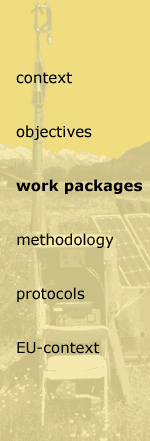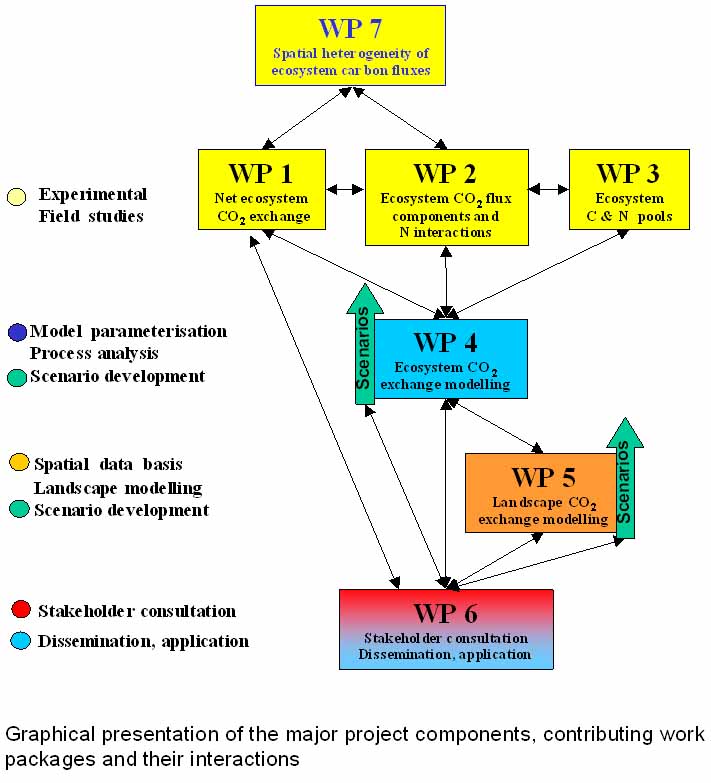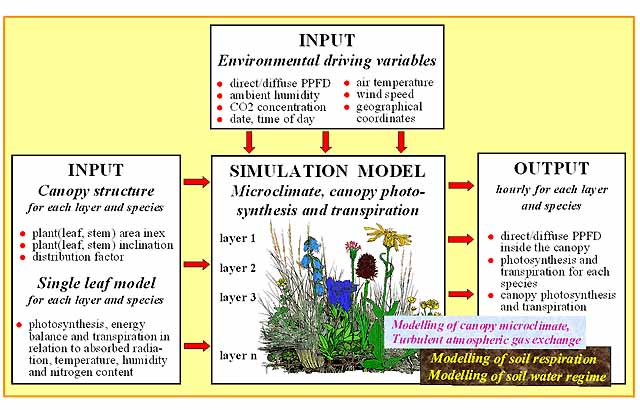

Workpackages
 At each CARBOMONT site integrated ecosystem studies will be conducted on differently managed ecosystems (such as meadows, pastures, abandoned areas, dwarf shrub communities). The work programme will include the following major research topics, structured into 7 different workpackages (WP):
At each CARBOMONT site integrated ecosystem studies will be conducted on differently managed ecosystems (such as meadows, pastures, abandoned areas, dwarf shrub communities). The work programme will include the following major research topics, structured into 7 different workpackages (WP):
WP 1: Net ecosystem CO2 exchange: Continuous measurements of net ecosystem CO2 exchange will be made using the Eddy-Covariance method. Alternative micrometeorological and chamber methods will be applied on non-ideal terrain. More Information
WP 2: Ecosystem CO2 flux components and their interaction with the nitrogen cycle: The contribution of the major ecosystem components to the net ecosystem CO2 exchange and their response to nitrogen contents and environmental driving forces will be estimated both in the field and laboratory using a variety of ecophysiological methods. Analysis of plant-level biomass partitioning and its relevance for the light and nitrogen use efficiency of carbon fluxes will permit an improved understanding of ecosystem component photosynthesis and respiration. Off-site carbon losses, which allow calculation of net biome production, will be estimated from literature and harvesting (WP 3) data. More Information
WP 3: Ecosystem carbon and nitrogen pools: Ecosystem carbon and nitrogen pool sizes and their major components in differently managed, non-forest mountain ecosystems will be assessed by harvesting periodically throughout the year. More Information
 WP 4 Ecosystem CO2 exchange modelling: The annual net ecosystem CO2 exchange of differently managed, non-forest mountain ecosystems will be simulated by means of a process-oriented soil-vegetation-atmosphere-transfer (SVAT) model. The corresponding input and validation data will be contributed by WP 1,2 and 3. More Information
WP 4 Ecosystem CO2 exchange modelling: The annual net ecosystem CO2 exchange of differently managed, non-forest mountain ecosystems will be simulated by means of a process-oriented soil-vegetation-atmosphere-transfer (SVAT) model. The corresponding input and validation data will be contributed by WP 1,2 and 3. More Information
WP 5: Landscape CO2 exchange modelling: The one-dimensional core model for non-forest mountain ecosystems developed in WP 4 will be inserted into a spatial framework that allows an evaluation of the annual carbon balances for landscape areas of approx. 100 km2 size. Within such landscape areas, carbon balances will be related to trends in land use change resulting from contrasting policy scenarios defined in WP 6. More Information
WP 6: Stakeholder consultation, dissemination and application of results: WP 6 aims
- to identify contrasting policy scenarios of land use in European mountain areas (input to WP 4 and 5),
- to disseminate the information on effects of different land-use scenarios on ecosystem and landscape carbon sequestration and
- to apply project results for training on sustainable rural development. Dissemination and application of results will include the on-line visualisation of net ecosystem CO2 exchange in the internet, workshops, transfer and mobility programmes of the EU and report-based recommendations to stakeholders. More Information
WP 7: Spatial heterogeneity of ecosystem carbon fluxes: The WP 7 aims to quantify the effects of the spatial heterogeneity of soils and vegetation on the ecosystem carbon fluxes using a combination of chamber measurements (Angell et al. 2001), a novel spatially explicit fluorescence imaging technique (Nedbal et al. 2000) and a footprint analysis (Baldocchi 1997). WP 7 will provide a further link between WP 1 and 2. More Information
